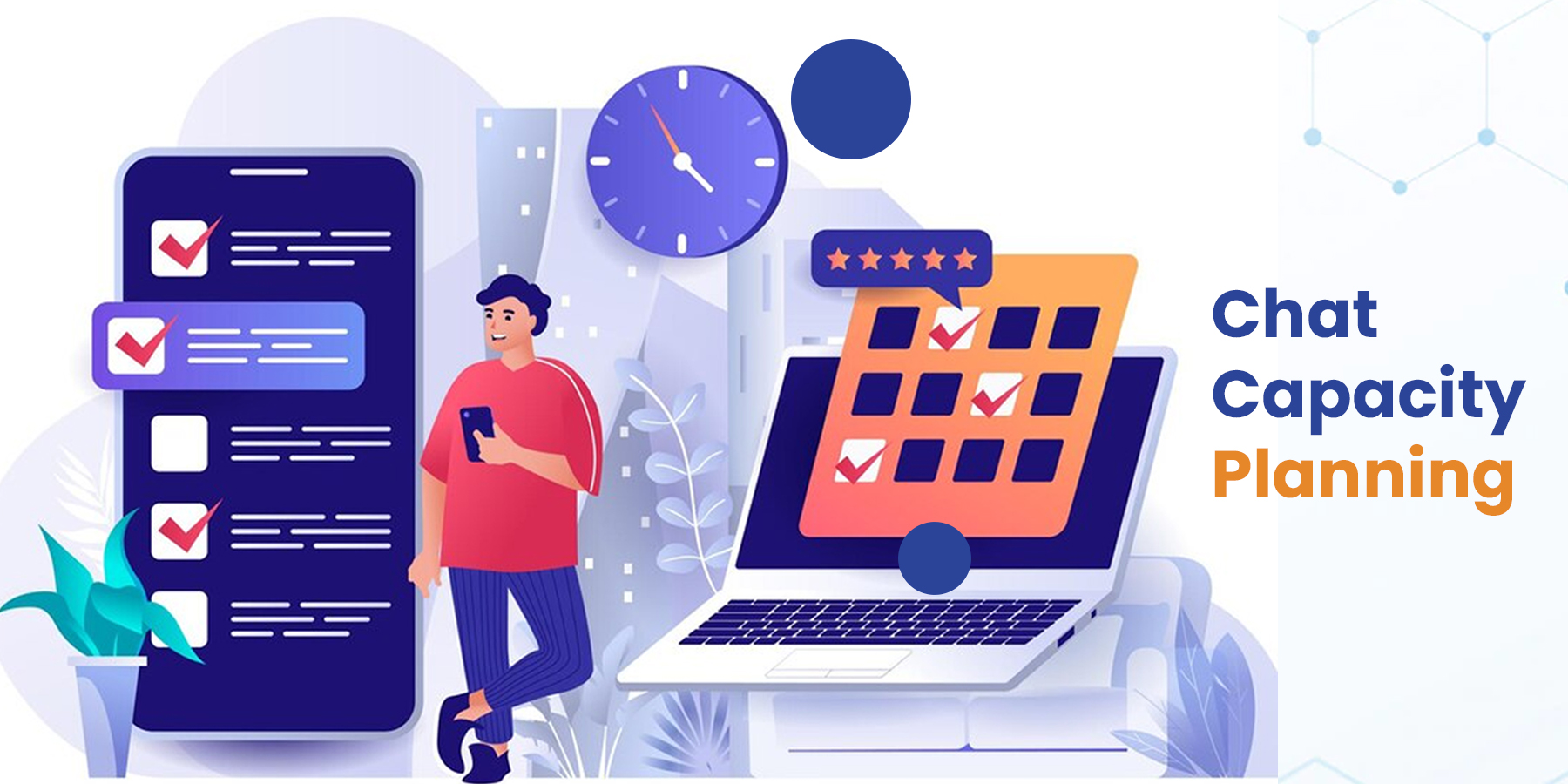
How do you plan for chat support services capacity planning in an ecommerce company? What are the critical elements involved in such a strategic decision? How would you allocate resources to develop the strategy?
Ecommerce businesses typically have a high volume of transactions per day. This means that they require the capability to handle large amounts of data efficiently. They also need to be able to respond rapidly to customers’ queries via live chat support services. Communicating effectively with customers is essential for maintaining brand perception and delivering exceptional experiences.
Today, let’s dive into an overview of customer service chat capacity planning in an ecommerce business.
What is Customer Service Capacity Planning?
Planning for live chat support services team capacity is one of the cornerstones of offering excellent customer service.
Your customer care representatives will feel overworked and understaffed if you outsource live chat support team with poor capacity planning. Over time, their production and level of productivity will decline. If your capacity planning is flawed, you won’t have a buffer to handle unforeseen circumstances that raise service demand, such as a product outage.
Compare that to a group that uses a successful staffing capacity approach. The squad won’t frequently face a burden that is too much for them to handle. They’ll have much more time to create the customer experience your clients seek. Since you’ve planned for them in your capacity model, you’ll have the resources to take on activities that aren’t in the support queue, like enhancing your self-service choices or working with the product.
So, how do you assess your present capabilities and make expansion plans for the future? by using some science in the arts? We shall examine the critical facets of capacity planning in this article.
Capacity Planning Is Important
Capacity planning determines the volume a single live chat support services team can successfully manage to fulfill present and future needs. Every chat support services manager must know how much work their team can do while meeting your established SLA requirements. Over time, you can retain a healthy staff by lowering the likelihood of agent burnout and keeping your budget at levels that executives want to see. To correctly estimate your demands, these measurements must be a continuous process that occurs at least four times each year.
Effective capacity planning lets your staff anticipate volume fluctuations rather than respond to longer response times and angry consumers. You’ll continuously feel overburdened if you don’t begin recruiting and training agents until your team is already in trouble. Planning for higher workloads is essential to your success because hiring and onboarding a new team member can take several months.
Tooling initiatives are included in the design as well. For instance, it might be helpful to compare the cost of a staff member managing that load vs. the cost of automation, bots, or machine learning technology that can help handle a given level of traffic. Tools are an excellent method to help your team work more efficiently, but if the cost outweighs the human effort, you can pay more for less benefit.
 Important Planning Ideas
Important Planning Ideas
When attempting to characterize capacity fully, there are five main factors to consider. Let’s review each one and provide examples to make this activity more accessible for you.
Shrinkage
To close the gap between the desired staffing and the realities of a team, shrinkage is a notion. There will be downtime during your team’s workweek if you don’t hire robots. Humans can’t be expected to work their 40-hour workweek—and they shouldn’t be expected to! There are two different kinds of shrinkage to consider:
- The amount of time an employee spends away from the workplace due to corporate policies like vacation, sick, or bereavement leave is known as external shrinkage.
- Occasionally, depending on the nature of your firm and the schedule you maintain, you could also add unintentional shrinkage or shrinkage resulting from poor performance, such as being late for work, taking lengthy lunches, and departing early.
- Internal shrinkage is the kind of shrinkage you bring into your firm. Breaks, meetings, training, one-on-one sessions, and professional development are a few examples of what should be included.
Some of these are simple to compute, while others are more challenging (This is one area where the art comes in).
Let’s imagine you have a team of agents working eight hours each day and a 22-day workweek to demonstrate this idea. The average time shrinking for each person may be shown on a graph.
You can see from this straightforward example that the shrinkage is 29% if the expectation is 176 hours per month. This indicates that your agent may work 125 hours in a work month.
You may estimate your capacity using this value. Each agent can handle 125 tickets per month, assuming you wish to maintain an average handling time per ticket of one hour. If you estimate that there will be 2,000 monthly tickets, you will need 16 agents.
Read this blog to learn the latest insights about ecommerce call centers in 2023: Customer Service Ecommerce 2023: News, Insights, and Industry Developments
Occupancy
Time is lost while waiting for access to arrive and personal space is shrinking. We refer to this possible downtime as occupancy. It is determined by:
Note that shrinking is not included in the “Total Time Available for Tickets.” In our case, the occupancy rate would be 100 hours / 125 hours, or 80%, if the agent worked 100 hours to resolve 100 monthly tickets.
There is no ideal occupancy level. Technical B2B enterprises or backline support teams could have reduced occupancy in the 75–80% range and focused extra time on proactive support initiatives like knowledge base audits and customer success chats. High-volume contact centers may operate at close to 100% occupancy.
By measuring this, burnout can be prevented. If occupancy is always 100%, you’ll need to add more team members or discover other ways to lighten the load, such as by finding tools or process improvements. If occupancy is persistently low, you may have too many employees.
Confluence and Channels
Because occupancy varies by channel, website chat services capacity planning will be more difficult. Staffing considerations differ depending on the channel. For instance, synchronous communication channels like emails can be closer to 100% occupied, allowing agents to go from one ticket to the next quickly.
In contrast, if all channels were in use, your agents might be unable to appropriately make ticket comments without creating a strain.
Additionally, you need agents to answer incoming chats since people demand an almost quick response when they chat. Unfortunately, you cannot anticipate receiving live chat one after the other as you prepare to answer them.
You should overstaff a chat support line that needs an instant response to keep your clients from waiting on hold.
On the other hand, an agent can manage two or three conversations at once. Because of this concurrency, they can process more tickets per hour than other channels.
Let’s assume an agent can manage two conversations concurrently and an occupancy of 80% to determine capacity with concurrence. If 800 talks are anticipated per month, it makes sense when we consider it. As mentioned, we decided an agent could handle 100 tickets at 80% occupancy. Four agents can manage 800 conversations if we double the concurrency since they can process 200 tickets simultaneously.
 Coverage
Coverage
Along with overlapping time zones and shifts, you should prepare for multilingual help, follow-the-sun handoffs, and tiers of support. Each of these will modify your calculations. For instance, Europeans frequently enjoy extended vacations more than Americans. The most accurate way to determine coverage is to utilize averages, primarily when many regional teams focus on the same ticket queues.
Beyond the mathematics mentioned above, language support also has to be considered. For instance, if you provide Spanish and English help, you might need to think about how to staff each line differently to guarantee that a native speaker is constantly on hand.
Since coverage is often not homogeneous, it introduces the most significant variables into your capacity planning. When doing these computations with an established team, most of the variation is usually accounted for by employing an extensive data set. Making more informed assumptions will be necessary if you assemble a new team.
Tooling
The wildcard of tooling comes last. Tooling can affect capacity by altering where your agents spend their time and lowering the number of tickets that arrive (also known as ticket deflection).
Examples:
Reducing time spent on repeated tickets and expanding your knowledge base with relevant, searchable material will enhance capacity.
Adding a bot to triage tickets may boost power and lower AHT.
We can avoid tickets by using in-product information to advise consumers proactively; however, this may take time from the agents.
It can be simple to decide whether tools will be helpful for you by comparing the number of tickets or the time they will save to the cost of the equivalent agent.
In our example, if we know that one agent can handle 100 tickets per month and a tool can cut that number down to 300, we may spend as much as three agents’ worth of fully loaded costs on the tool and still save money by transferring our capacity to a device.
This quick estimate provides a general notion of how a device will affect your capacity predictions and its return on investment. ROI, however, disregards how this modifies the consumer experience. Depending on your objectives, this can be a crucial factor to consider.
 Final Thoughts
Final Thoughts
Live chat support services capacity planning might appear to be difficult since so many factors exist. However, don’t panic. As your team develops, you may always make changes. It’s possible that a small support staff merely needs the fundamentals of capacity planning. Big international groups could require full-time workforce management staff for daily capacity assessments.
This article discusses the fundamental ideas behind capacity planning. You may develop a model that works for your team using these ideas in various ways.
We at Vserve offer the best live chat support services. Outsourcing to us will increase client happiness and facilitate a smooth purchasing experience. We will offer your clients effective and prompt chat support services, from general queries to grievance resolutions.
We will organize our internal cooperation to increase conversion rates and lower the cost of customer handling operations. You may utilize your time and resources on other business opportunities since Vserve will ensure the chat support staff effectively manages every part.








